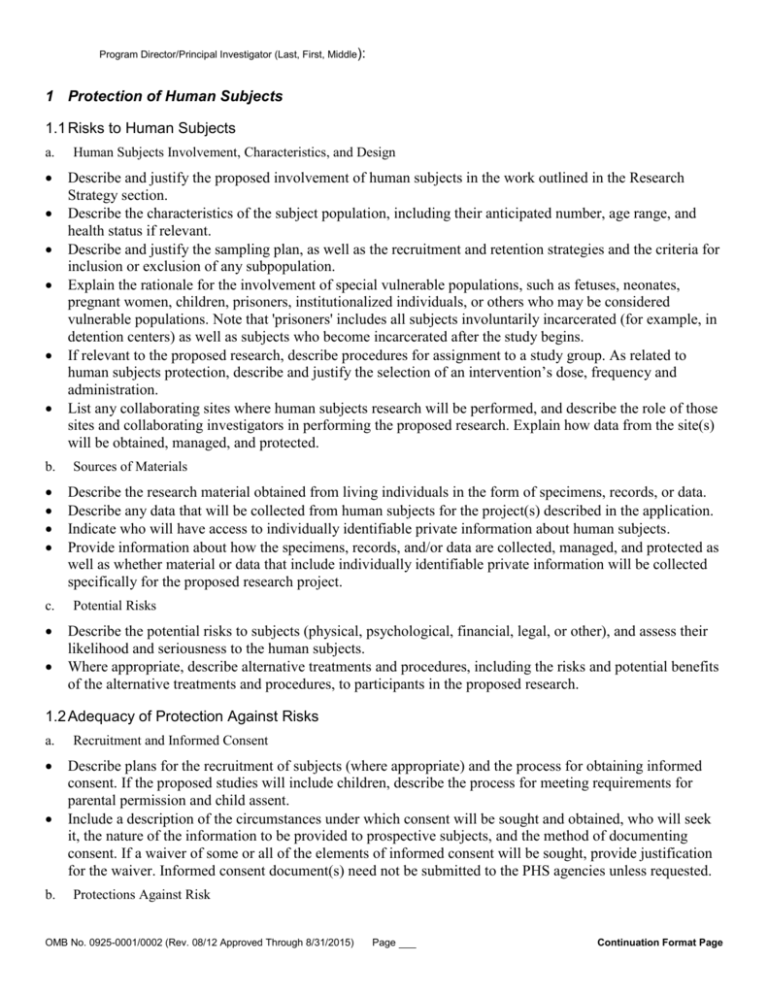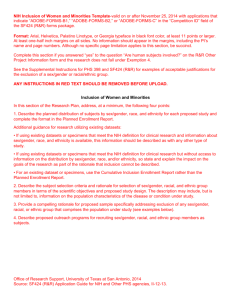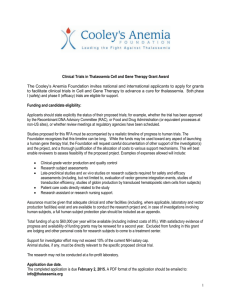here
advertisement

Program Director/Principal Investigator (Last, First, Middle): 1 Protection of Human Subjects 1.1 Risks to Human Subjects a. b. c. Human Subjects Involvement, Characteristics, and Design Describe and justify the proposed involvement of human subjects in the work outlined in the Research Strategy section. Describe the characteristics of the subject population, including their anticipated number, age range, and health status if relevant. Describe and justify the sampling plan, as well as the recruitment and retention strategies and the criteria for inclusion or exclusion of any subpopulation. Explain the rationale for the involvement of special vulnerable populations, such as fetuses, neonates, pregnant women, children, prisoners, institutionalized individuals, or others who may be considered vulnerable populations. Note that 'prisoners' includes all subjects involuntarily incarcerated (for example, in detention centers) as well as subjects who become incarcerated after the study begins. If relevant to the proposed research, describe procedures for assignment to a study group. As related to human subjects protection, describe and justify the selection of an intervention’s dose, frequency and administration. List any collaborating sites where human subjects research will be performed, and describe the role of those sites and collaborating investigators in performing the proposed research. Explain how data from the site(s) will be obtained, managed, and protected. Sources of Materials Describe the research material obtained from living individuals in the form of specimens, records, or data. Describe any data that will be collected from human subjects for the project(s) described in the application. Indicate who will have access to individually identifiable private information about human subjects. Provide information about how the specimens, records, and/or data are collected, managed, and protected as well as whether material or data that include individually identifiable private information will be collected specifically for the proposed research project. Potential Risks Describe the potential risks to subjects (physical, psychological, financial, legal, or other), and assess their likelihood and seriousness to the human subjects. Where appropriate, describe alternative treatments and procedures, including the risks and potential benefits of the alternative treatments and procedures, to participants in the proposed research. 1.2 Adequacy of Protection Against Risks a. b. Recruitment and Informed Consent Describe plans for the recruitment of subjects (where appropriate) and the process for obtaining informed consent. If the proposed studies will include children, describe the process for meeting requirements for parental permission and child assent. Include a description of the circumstances under which consent will be sought and obtained, who will seek it, the nature of the information to be provided to prospective subjects, and the method of documenting consent. If a waiver of some or all of the elements of informed consent will be sought, provide justification for the waiver. Informed consent document(s) need not be submitted to the PHS agencies unless requested. Protections Against Risk OMB No. 0925-0001/0002 (Rev. 08/12 Approved Through 8/31/2015) Page Continuation Format Page Program Director/Principal Investigator (Last, First, Middle): Describe planned procedures for protecting against or minimizing potential risks, including risks to privacy of individuals or confidentiality of data, and assess their likely effectiveness. Research involving vulnerable populations, as described in the DHHS regulations, Subparts B-D must include additional protections. Refer to DHHS regulations, and OHRP guidance: Additional Protections for Pregnant Women, Human Fetuses and Neonates: http://www.hhs.gov/ohrp/humansubjects/guidance/45cfr46.html#subpartb Additional Protections for Prisoners: http://www.hhs.gov/ohrp/humansubjects/guidance/45cfr46.html#subpartc OHRP Subpart C Guidance: http://www.hhs.gov/ohrp/policy/index.html#prisoners Additional Protections for Children: http://www.hhs.gov/ohrp/humansubjects/guidance/45cfr46.html#subpartd OHRP Subpart D Guidance: http://www.hhs.gov/ohrp/policy/index.html#children Where appropriate, discuss plans for ensuring necessary medical or professional intervention in the event of adverse effects to the subjects. Studies that involve clinical trials (biomedical and behavioral intervention studies) must include a general description of the plan for data and safety monitoring of the clinical trials and adverse event reporting to the IRB, the NIH and others, as appropriate, to ensure the safety of subjects. 1.3 Potential Benefits of the Proposed Research to Human Subjects and Others Discuss the potential benefits of the research to research participants and others. Discuss why the risks to subjects are reasonable in relation to the anticipated benefits to research participants and others. 1.4 Importance of the Knowledge to be Gained Discuss the importance of the knowledge gained or to be gained as a result of the proposed research. Discuss why the risks to subjects are reasonable in relation to the importance of the knowledge that reasonably may be expected to result. NOTE: Test articles (investigational new drugs, devices, or biologics) including test articles that will be used for purposes or administered by routes that have not been approved for general use by the Food and Drug Administration (FDA) must be named. State whether the 30-day interval between submission of applicant certification to the FDA and its response has elapsed or has been waived and/or whether use of the test article has been withheld or restricted by the FDA, and/or the status of requests for an Investigational New Drug (IND) or Investigational Device Exemption (IDE) covering the proposed use of the test article in the Research Plan. 1.5 Data and Safety Monitoring Plan The NIH Data and Safety Monitoring Policy is described and referenced in Section 5.3. If the proposed research includes a clinical trial, create a heading entitled "Data and Safety Monitoring Plan." Provide a general description of a monitoring plan that you plan to establish as the overall framework for data and safety monitoring. Describe the entity that will be responsible for monitoring and the process by which Adverse Events (AEs) will be reported to the Institutional Review Board (IRB), the funding I/C, the NIH Office of Biotechnology Activities (OBA), and the Food and Drug Administration (FDA) in accordance with Investigational New Drug (IND) or Investigational Device Exemption (IDE) regulations. Be succinct. Contact the FDA (http://www.fda.gov/) and also see the following Web sites for more information related to IND and IDE requirements: http://www.access.gpo.gov/nara/cfr/waisidx_01/21cfr312_01.html (IND) http://www.access.gpo.gov/nara/cfr/waisidx_01/21cfr812_01.html (IDE) OMB No. 0925-0001/0002 (Rev. 08/12 Approved Through 8/31/2015) Page Continuation Format Page Program Director/Principal Investigator (Last, First, Middle): The frequency of monitoring will depend on potential risks, complexity, and the nature of the trial; therefore, a number of options for monitoring trials are available. These can include, but are not limited to, monitoring by a: a. PD/PI (required) b. Institutional Review Board (IRB) (required) c. Independent individual/safety officer d. Designated medical monitor e. Internal Committee or Board with explicit guidelines f. Data and Safety Monitoring Board (DSMB). NIH specifically requires the establishment of Data and Safety Monitoring Boards (DSMBs) for multi-site clinical trials involving interventions that entail potential risk to the participants, and generally for Phase III clinical trials. Although Phase I and Phase II clinical trials may also need DSMBs, smaller clinical trials may not require this oversight format, and alternative monitoring plans may be appropriate. A detailed Data and Safety Monitoring Plan must be submitted to the applicant's IRB and subsequently to the funding IC for approval prior to the accrual of human subjects. For additional guidance on creating this Plan see http://grants.nih.gov/grants/guide/notice-files/NOT-OD-00-038.html. 1.6 ClinicalTrials.gov Requirements Public Law 110-85 (also known as the FDA Amendments Act (FDAAA) of 2007) mandates registration and results reporting of "applicable clinical trials" in ClinicalTrials.gov. Under the statute these trials generally include: (1) Trials of Drugs and Biologics: Controlled, clinical investigations, other than Phase 1 investigations, of a product subject to FDA regulation; and (2) Trials of Devices: Controlled trials with health outcomes, other than small feasibility studies, and pediatric postmarket surveillance. Review the statutory definition of applicable clinical trial to identify if registration is required to comply with the law (See PL 110-85, Section 801(a), adding new 42 U.S.C. 282(j)(1)(A)). NIH encourages registration of ALL clinical trials whether required under the law or not. Registration is accomplished at the ClinicalTrials.gov Protocol Registration System Information Web site (http://prsinfo.clinicaltrials.gov/). A unique identifier called an NCT number, or ClinicalTrials.gov registry number, will be generated during the registration process. The NIH implementation of FDAAA requires: the registration of applicable clinical trials in ClinicalTrials.gov no later than 21 days after the first subject is enrolled, the reporting of summary results information (including adverse events) no later than 1 year after the completion date for registered applicable clinical trials involving drugs that are approved under section 505 of the Food, Drug and Cosmetic Act (FDCA) or licensed under section 351 of the PHS Act, biologics, or of devices that are cleared under section 510k of FDCA, and if an “applicable clinical trial” is funded in whole or in part by an NIH grant or cooperative agreement, grant and progress report forms shall include a certification that the responsible party has made all required submissions to ClinicalTrials.gov. For competing new and renewal applications that include applicable clinical trials which require registration and results reporting under FDAAA, provide the NCT number/s in the human subjects section of the Research Plan under a section heading entitled ClinicalTrials.gov. The entity responsible for registering the trial is the “responsible party”. The statute defines the responsible party as: OMB No. 0925-0001/0002 (Rev. 08/12 Approved Through 8/31/2015) Page Continuation Format Page Program Director/Principal Investigator (Last, First, Middle): (1) the sponsor of the clinical trial (as defined in 21 CFR 50.3) (http://www.accessdata.fda.gov/scripts/cdrh/cfdocs/cfcfr/CFRSearch.cfm?fr=50.3), or (2) the principal investigator of such clinical trial if so designated by a sponsor, grantee, contractor, or awardee (provided that “the principal investigator is responsible for conducting the trial, has access to and control over the data from the clinical trial, has the right to publish the results of the trial, and has the ability to meet all of the requirements” for submitting information under the law) (http://frwebgate.access.gpo.gov/cgibin/getdoc.cgi?dbname=110_cong_public_laws&docid =f:publ085.110.pdf). See PL 110-85, Section 801(a), (adding new 42 U.S.C. 282(j)(1)(A)(ix)). For the complete statutory definitions of "responsible party" and "applicable clinical trial," refer to Elaboration of Definitions of Responsible Party and Applicable Clinical Trial. The signature on the application of the Authorized Organization Representative assures compliance with FDAAA. Additional information can be found on the ClinicalTrials.gov Web site (http://grants.nih.gov/ClinicalTrials_fdaaa/). 2 Inclusion of Women and Minorities Create a section heading entitled "Inclusion of Women and Minorities" and place it immediately following the “Protection of Human Subjects" section. Although no specific page limitation applies to this section of the application, be succinct. The NIH Policy on the Inclusion of Women and Minorities in Clinical Research is described and referenced in Section 5.6. Scientific Review Groups will assess each application as being acceptable or unacceptable with regard to the inclusion of women and minorities in NIH-defined clinical research. In this section of the Research Plan, address, at a minimum, the following four points: 1. The targeted/planned distribution of subjects by sex/gender, race, and ethnicity for each proposed study or protocol using the format in the Targeted/Planned Enrollment Table. If using existing specimens and/or data without access to information on the distribution of women and minorities, so state and explain the impact on the goals of the research as part of the rationale that inclusion cannot be described (item 3 below). Alternatively, describe the sex/gender, racial, and ethnic composition of the population base from whom the specimens and/or data will be obtained. Include the Targeted/Planned Enrollment Tables in this section. 2. A description of the subject selection criteria and rationale for selection of sex/gender, racial, and ethnic group members in terms of the scientific objectives and proposed study design. The description may include, but is not limited to, information on the population characteristics of the disease or condition under study. 3. A compelling rationale for proposed exclusion of any sex/gender, racial, or ethnic group (see examples below). 4. A description of proposed outreach programs for recruiting sex/gender, racial, and ethnic group members as subjects. Below are examples of acceptable justifications for the exclusion of: A. One sex/gender: 1. One sex/gender is excluded from the study because: inclusion of these individuals would be inappropriate with respect to their health; the research question addressed is relevant to only one sex/gender; evidence from prior research strongly demonstrates no difference between sexes/genders; or sufficient data already exist with regard to the outcome of comparable studies in the excluded sex/gender, and duplication is not needed in this study. 2. One sex/gender is excluded or severely limited because the purpose of the research constrains the applicant's selection of study subjects by sex/gender (e.g., uniquely valuable stored specimens or existing datasets are single OMB No. 0925-0001/0002 (Rev. 08/12 Approved Through 8/31/2015) Page Continuation Format Page Program Director/Principal Investigator (Last, First, Middle): sex/gender; very small numbers of subjects are involved; or overriding factors dictate selection of subjects, such as matching of transplant recipients, or availability of rare surgical specimens). 3. Sex/gender representation of specimens or existing datasets cannot be accurately determined (e.g., pooled blood samples, stored specimens, or data-sets with incomplete sex/gender documentation are used), and this does not compromise the scientific objectives of the research. B. Racial and/or ethnic groups or subgroups: 1. Some or all racial and/or ethnic groups or subgroups are excluded from the study because: inclusion of these individuals would be inappropriate with respect to their health; the research question addressed is relevant to only specific racial or ethnic groups; evidence from prior research strongly demonstrates no differences between racial or ethnic groups on the outcome variables; a specific racial or ethnic group(s) study is proposed to fill a research gap; or sufficient data already exists with regard to the outcome of comparable studies in the excluded racial or ethnic groups and duplication is not needed in this study. 2. Some racial or ethnic groups or subgroups are excluded or poorly represented because the geographical location of the study has only limited numbers of these groups who would be eligible for the study, and the investigator has satisfactorily addressed this issue in terms of: the size of the study; the relevant characteristics of the disease, disorder or condition; or the feasibility of making a collaboration or consortium or other arrangements to include representation. In general, cost is not an acceptable justification for exclusion. 3. Some racial or ethnic groups or subgroups are excluded or poorly represented because the purpose of the research constrains the applicant's selection of study subjects by race or ethnicity (e.g., uniquely valuable cohorts, stored specimens or existing datasets are of limited racial and/or ethnic representation, very small numbers of subjects are involved, or overriding factors dictate selection of subjects, such as matching of transplant recipients or availability of rare surgical specimens). Racial or ethnic origin of specimens or existing datasets cannot be accurately determined (e.g., pooled blood samples, stored specimens or data sets with incomplete racial and/or ethnic documentation are used) and this does not compromise the scientific objectives of the research. 3 Inclusion of Children The NIH Policy on Inclusion of Children is referenced and described in Section 5.7. Instructions for item 9 of the Research Plan (for F applicants, item 12 on PHS Fellowship Supplemental Form – Research Training Plan) are as follows: Create a section entitled “Inclusion of Children” and place it immediately following the section on the Inclusion of Women and Minorities and the Targeted/Planned Enrollment Table(s). For the purpose of implementing these guidelines, a child is defined as an individual under the age of 21 years (for additional information see http://grants.nih.gov/grants/funding/children/children.htmhttp://grants.nih.gov/grants/guide/noticefiles/not98-024.html). Provide either a description of the plans to include children, including the particular age ranges to be included, or, if children (or a subset) will be excluded from the proposed research, application, or proposal, present an acceptable justification for the exclusion (see below). If children are included, the description of the plan should include a rationale for selecting a specific age range of children. The plan also must include a description of the expertise of the investigative team for working with children at the ages included, of the appropriateness of the available facilities to accommodate OMB No. 0925-0001/0002 (Rev. 08/12 Approved Through 8/31/2015) Page Continuation Format Page Program Director/Principal Investigator (Last, First, Middle): the children, and the inclusion of a sufficient number of children to contribute to a meaningful analysis relative to the purpose of the study. Scientific Review Groups will assess each application as being acceptable or unacceptable with regard to the age-appropriate inclusion or exclusion of children in the proposed research project. When children are involved in research, the Additional Protections for Children Involved as Subjects in Research (45 CFR part 46 Subpart D) apply and must be addressed under the Protections Against Risk subheading (1.2.b). Justifications for Exclusion of Children For the purposes of this policy, all individuals under 21 are considered children; however, exclusion of any specific age group, such as individuals under 18, should be justified in this section. It is expected that children will be included in all NIH-defined clinical research unless one or more of the following exclusionary circumstances apply: 1. The research topic to be studied is not relevant to children. 2. Laws or regulations bar the inclusion of children in the research. 3. The knowledge being sought in the research is already available for children or will be obtained from another ongoing study, and an additional study will be needlessly redundant. Documentation of other studies justifying the exclusions should be provided. NIH program staff can be contacted for guidance on this issue if the information is not readily available. 4. A separate, age-specific study in children is warranted and preferable. Examples include: a. The condition is relatively rare in children, as compared to adults (in that extraordinary effort would be needed to include children, although in rare diseases or disorders where the applicant has made a particular effort to assemble an adult population, the same effort would be expected to assemble a similar child population with the rare condition); or b. The number of children is limited because the majority are already accessed by a nationwide pediatric disease research network; or c. Issues of study design preclude direct applicability of hypotheses and/or interventions to both adults and children (including different cognitive, developmental, or disease stages or different age-related metabolic processes). While this situation may represent a justification for excluding children in some instances, consideration should be given to taking these differences into account in the study design and expanding the hypotheses tested, or the interventions planned, to allow inclusion of children rather than excluding them. 5. Insufficient data are available in adults to judge potential risk in children (in which case one of the research objectives could be to obtain sufficient adult data to make this judgment). Although children usually should not be the initial group to be involved in research studies, in some instances, the nature and seriousness of the illness may warrant their participation earlier based on careful risk and benefit analysis. 6. Study designs are aimed at collecting additional data on pre-enrolled adult study subjects (e.g., longitudinal follow-up studies that did not include data on children). 7. Other special cases can be justified by the investigator and found acceptable to the review group and the Institute/Center Director. OMB No. 0925-0001/0002 (Rev. 08/12 Approved Through 8/31/2015) Page Continuation Format Page









